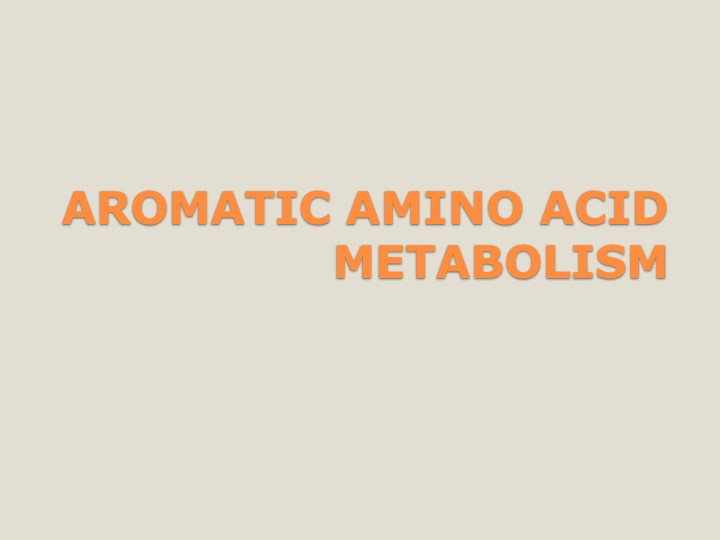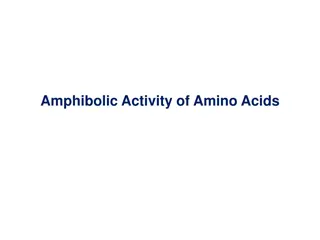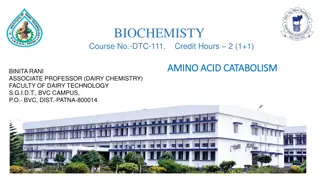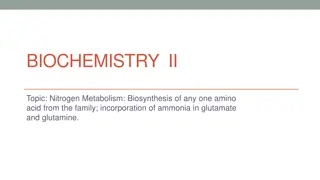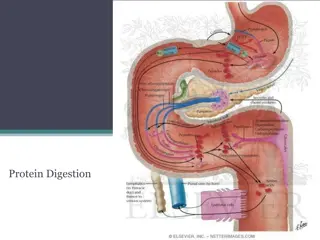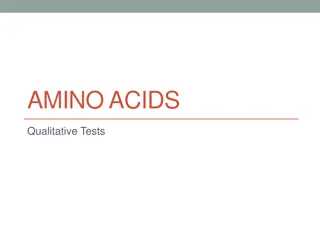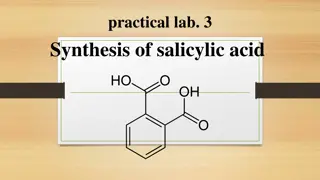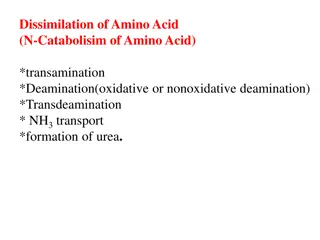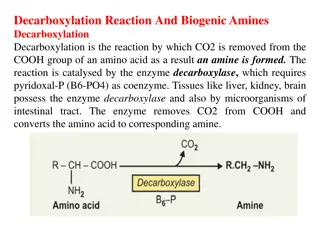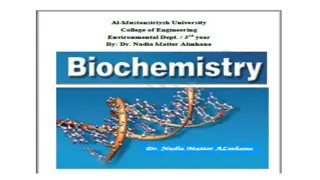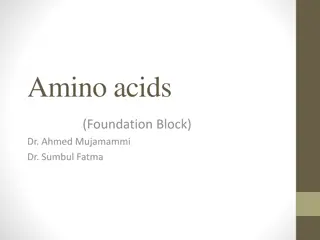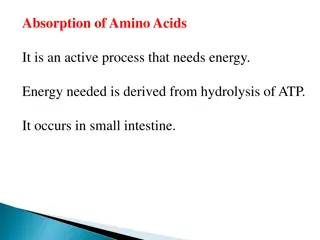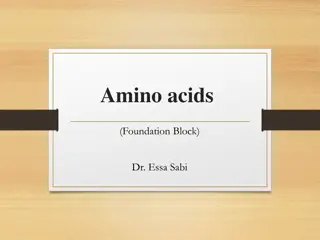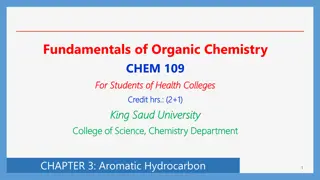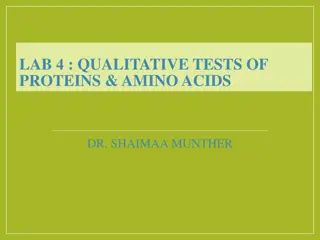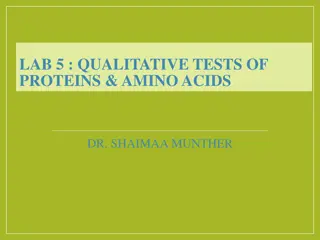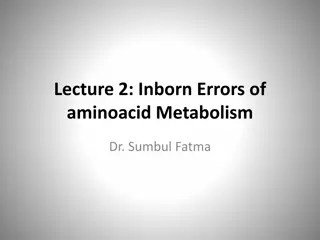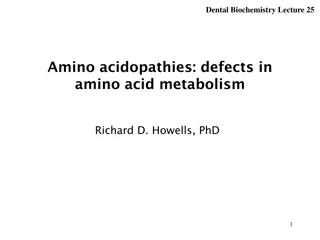AROMATIC AMINO ACID METABOLISM
Aromatic amino acids, including phenylalanine, tyrosine, and tryptophan, play essential roles in metabolism. Phenylalanine is converted to tyrosine through a key irreversible reaction involving co-enzymes. The metabolism of these amino acids occurs in the liver through specific pathways catalyzed by various enzymes, such as phenylalanine hydroxylase and p-hydroxyphenylpyruvate hydroxylase. Understanding the conversion process is vital for grasping the production of neurotransmitters like dopamine, norepinephrine, and epinephrine.
Download Presentation

Please find below an Image/Link to download the presentation.
The content on the website is provided AS IS for your information and personal use only. It may not be sold, licensed, or shared on other websites without obtaining consent from the author.If you encounter any issues during the download, it is possible that the publisher has removed the file from their server.
You are allowed to download the files provided on this website for personal or commercial use, subject to the condition that they are used lawfully. All files are the property of their respective owners.
The content on the website is provided AS IS for your information and personal use only. It may not be sold, licensed, or shared on other websites without obtaining consent from the author.
E N D
Presentation Transcript
AROMATIC AMINO ACID METABOLISM
Aromatic amino acid contains aromatic ring . They are- Phenylalanine(Benzene ring or phenyl) Tyrosine(phenol) Tryptophane(indole)
PHENYLALANINE Essential amino acid Partially glucogenic and partially ketogenic. The only function of phenylalanine is its conversion to tyrosine. For this reason ingestion of tyrosine can reduce the dietary requirement of phenylalanine. This phenomenon known as spring action of tyrosine on phenylalanine.
CONVERSION OF PHENYLALANINE TO TYROSINE The degradation of phenylalanine mostly occurs through tyrosine. The reaction involves addition of a hydroxyl group to the aromatic ring. It needs NADPH,NADH,and tetra- hydrobiopterin as co-enzyme. This is an irreversible reaction and tyrosine cannot replenish phenylalanine.
P H E NY L AL A NI N E T Y R O S I N E MELANINE DOPAMINE Phenylalanine hydroxylase NOREPINEPHRINE EPINEPHRINE THYROXINE Metabolism of Tyrosine
The metabolism of phenylalanine and tyrosine is considered together. As phenylalanine is converted to tyrosine a single pathway is responsible for the degradation of both these amino acids,which mostly occurs in liver. Tyr first undergoes transamination to give P- hydroxyphenylpyruvate. this reaction is catalysed by tyrosine transaminase.
P-hydroxyphenylpyruvate hydroxylase(dioxygenase)is a copper containing enzyme. It catalyses oxidative decarboxylation as well as hydroxylation of phenyl ring to produce HOMOGENTISATE. A shifting of OH group from Para to meta position occur,and incorporates a new hydroxyl group at para position.
This reaction requires ascorbic acid. HOMOGENTISATE OXIDASE cleaves the bengene ring of homogentisate to form 4- maleylacetoacetate. Maleylacetoacetate isomarised to form 4- fumaryl acetoacetate and this reaction is catalysed by maleylacetoacetate isomarase.
maleyl acetoacetate is get converted into fumaryl acetoacetate with the help of fumarylacetoacetase. Fumaryl acetoacetate hydrolysed in to fumarate and acetoacetate with the help of enzyme fumarylacetoacetase.
SYNTHESIS OF MELANINE It is pigment of skin,hair and eyes. Tyrosine is the precursor of melanine. Tyrosinase enzyme required for its synthesis. Tyrosinase hydroxylas tyrosine to form 3,4- dihydroxyphenylalanine(DOPA). Dopa is converted to dopaquinone. A subsequent couple of reactionoccurs. Formation of leucodopachrome and indole 5-6 quinone.
Tyrosine Tyrosinase DOPA Dopamine Cysteine Leucodopachrome Melanin red polymers 5,6-Dihydroxyindole Indole 5-6-quinone Tyrosinase Melanin black polymers melanochrome
Cysteine condenses with dopaquinone and series of reactions results in synthesis of red melanines
Tyrosine is also required for thyroid hormone and catecholamine synthesis. Tyrosine is precursor for the synthesis of dopamine,norepinephrine and epinephrine. For the formation of dopa the enzyme required is TYROSINE HYDROXYLASE.
Melanin, a color pigment Skin color is determined by the relative concentrations of black & red melanins This is dependent on genetic and environmental factors Formation of moles is due to hyperpigmentation caused by the hyperactivity of melanocytes and formation of white patches is due to localized absence or degeneration of melanoytes from the skin. Albinism is an inborn error with generalized lack of melanin synthesis
What is albinism? Albinism is a group of genetic conditions that causes a lack of pigment. It can effect only the eyes or both the eyes and skin. Most types of albinism are inherited when an individual receives the albinism gene from both parents. The exception is one type of ocular albinism, which is passed on from mothers to their sons.
Description Due to the defect in tyrosine metabolism it results in a deficiency of melanin production and partial or full absence of pigment from the skin, hair,and eyes It may be inherited by one of several modes: autosomal recessive, autosomal dominant, or Complete albinism Affected people may appear to have white hair, skin & iris color. They may have vision defects and photophobia. Oculocutaneous albinism is most severe form resulting from a deficiency of tyrosinase activity, causing a total absence of pigment from the hair, eyes & skin
Detection Detected at birth because of irregular pigmentation
Symptoms Absence of pigment from the hair, skin, or iris of eyes Lighter than normal skin and hair or complete albinism Most forms of complete albinism have some of the following possible symptoms: Rapid eye movements Strabismus (eyes not tracking properly) Photophobia (avoidance of light because of discomfort) Decreased visual acuity Functionalblindness
Causes Albinism is caused by an alteration of the gene that regulates the melanin pigment synthesis.
Alternate names Hypopigmentation OcularAlbinism OculocutaneousAlbinism
Prevalence Approximately one in 17,000 people have one of the types of albinism. About18,000 people in the United States areaffected.
Diagnosis The most accurate way to determine albinism and the specific type is genetictesting
Treatment The skin and eyes must be protected from the sun. Sunglasses (UV protected) may relieve photophobia.
Prognosis Albinism does not affect theexpected lifespan. Activities may be limited by intolerance to the sun.
Complications Skin cancer Decreased vision,blindness
TRYPTOPHAN Essential aminoacid. Contains an indole ring. It s a alpha amino beta indole propionic acid. Tryptophane is both glucogenic and ketogenic. It is precursor of NAD+ and NADP+ serotonin and melatonin.
METABOLISM OF TRYPTOPHAN Divided into- 1-kynureninepathway 2-serotonin pathway
KYNURENINE PATHWAY Mostly occurs in liver. Tryptophan converted in to N- formylkynurenine with the help of enzyme tryptophan pyrrolase. Formamidase hydrolases formyl kynurenine and liberates formate and kynurenine. Kynurenine undergose NADPH-dependent hydroxylation to give 3-hydroxykynurenine.
Kynureninase, a pyridoxal phosphate dependent enzyme acts on the 3-hydroxy kynurenine and splits off alanine. Due to the lack of PLP kynureninase reaction is blocked and 3-hydroxy kynurenine is diverted to form xenthurenate, serves as an indication of vitamin B6 deficiency. 3-hydroxy anthranilate is cleaved by an oxidase to form an unstable intermediate 2-amino 3carboxy muconatesemialdehyde.
This compound has 3 fates- 1-Spontaneous cyclization to form quinolinate for NAD+ synthesis. 2-To produce picolinate. 3-To produce 2-aminomuconate for acetyl CO.A synthesis.
Tryptophan is also produces indole acetate. Tryptophan is not precursor for the synthesis of niacin. Quinolinate under gose decarboxylation and form nicotinate mononucleotide by the enzyme quinolinate phosphoribosyl transferase.
SEROTONINPATHWAY It is a neurutransmitter, syntheseized from tryptophan. Only 1% of tryptophan is converted in to serotonin. The production of 5HT occurs in the target tissues.
Synthesis of serotonin Synthesized in the intestinal cells. Tryptophane is first hydroxylated at 5th carbon by tryptophane hydroxylase. This enzyme requires tetrahydrobiopterin as a co factor. 5-hydroxytryptophane is decarboxylated by aromatic amino acid decarboxylase to give serotonin.
Degradation and functions of serotonin Monoamine oxidase degrades serotonin to 5- hydroxy indole acetate which is excreted in urine. Functions- 1-as a powerfulVASOCONSTRICTOR. 2-involves in regulation of cerebral activity. 3-controls beheviourals patterns,sleep,blood pressure and body temprature.
4-evokes the release of peptide hormones. 5-also necessary for the motility of GIT.
